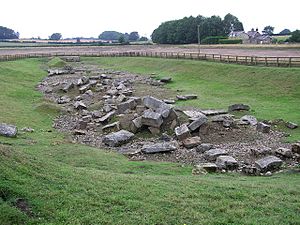Piercebridge Roman Bridge facts for kids
Quick facts for kids Piercebridge Roman Bridge |
|
|---|---|

Piercebridge Roman Bridge
|
|
| Location | County Durham, England, UK |
| OS grid reference | NZ213156 |
| Lua error in Module:Location_map at line 420: attempt to index field 'wikibase' (a nil value). | |
The Piercebridge Roman Bridge is what's left of an old Roman bridge in County Durham, England. It once crossed the River Tees near the village of Piercebridge. This bridge was a very important part of the Roman road system in Britain.
In 2009, a TV show called Time Team did some digging here. They helped us learn even more about this ancient structure.
Contents
What Was the Piercebridge Roman Bridge?
This Roman bridge was a key crossing point for Dere Street. Dere Street was a major Roman road that connected different parts of Roman Britain. The bridge helped people and goods travel across the River Tees.
Right next to the bridge was the Piercebridge Roman Fort. This fort was like a guard station. Its job was to protect the bridge and the important road.
When Was the Bridge Built?
The first bridge at Piercebridge was built around the year 90 AD. That's almost 2,000 years ago! However, this first bridge might have been washed away by the river. If it was, the Romans would have built a second bridge to replace it.
Over many centuries, the River Tees has changed its path. It has also become narrower. This is why the bridge's remains are now in a field. They are about 90 meters (300 feet) south of where the river flows today. They are also about 450 meters (1,476 feet) east of the modern village of Piercebridge.
What Can We See Today?
Today, you can still see large stone blocks from the bridge. These blocks formed at least five strong piers. Piers are the supports that hold up a bridge. You can also see parts of one of the abutments. An abutment is the structure that connects the bridge to the land.
You might even spot holes in the stone. These holes show where the wooden parts of the bridge used to fit. All the wood has disappeared over the past 1,600 years.
The remains of the bridge were found in 1972. This happened when people were digging for gravel in the area. The stone blocks are very big, some up to 1.5 meters (5 feet) long. The whole bridge was once about 123 meters (403 feet) long.
You can see items found during the digging at the Bowes Museum. These items include things from both the bridge and the nearby Roman fort.
See also
 In Spanish: Puente romano de Piercebridge para niños
In Spanish: Puente romano de Piercebridge para niños

